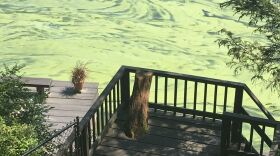The Lake Champlain Basin Program has released its tri-annual State of the Lake Report. The assessment that reviews the water quality of Lake Champlain finds some progress has been made in cleaning up the lake, but new challenges are emerging.
Watershed officials from Vermont, New York and Quebec joined the Basin Program virtually for the release of the 2021 Lake Champlain State of the Lake and Ecosystems Indicators Report.
Vermont Senator Patrick Leahy, a Democrat and chair of the Appropriations Committee, has consistently secured millions of dollars in funding for the program. He provided recorded comments, noting that the report is a go-to document for anyone seeking information about the lake.
“Lake Champlain’s a very complex and constantly changing ecosystem," Leahy said. "We need up-to-date, trustworthy, concise, practical and especially understandable information about the lake. Can we swim in the lake? Can we drink the lake water that comes from our taps? Can we eat the fish that we catch? Are investments in cleaning up having an impact? And what are the trends we should be tracking? Well the State of the Lake report addresses these questions and more.”
In 1990 Congress approved the Lake Champlain Special Designation Act, which created the Lake Champlain Basin Program. It allocates funds to lake projects in Vermont, New York and Quebec. Lake Champlain Basin Program Director Dr. Eric Howe said the latest report is oriented around the program’s four key goals.
“The report begins with the clean water section which provides a picture of the water quality of the lake including nutrients, mainly phosphorus and cynobacteria or blue green algae, and other water quality elements," Howe said. "The next segment of the report focuses on healthy ecosystems. In the third section, Thriving Communities, that is focused on connecting the health of our communities to the health of the lake. And then finally the informed and involved public section of the report looks at educating our community members of the basin about the lake issues.”
Some information in the 2021 report has not appeared in previous versions. These include the influence of nitrogen and phosphorus on algae blooms; lake freezing trends; microplastic pollution and the impact of increased recreational use due to the COVID-19 pandemic. Basin staff provided summaries of each report segment. Aquatic Nuisance Species Management Coordinator Meg Modley Gilbertson outlined climate change impacts including a new assessment of the impact of climate change by tracking how often Lake Champlain fully freezes in winter.
“Air temperatures are rising and the lake is freezing over less often compared to the turn of the 20th century," Gilbertson explained. "In the early 1900’s the surface of Lake Champlain froze nearly every year. Currently the lake freezes about once every four years. And modeling suggests that by 2050 the lake may freeze over just once per decade. The impacts of climate change on habitats, fish and wildlife are more difficult to measure. Lake Champlain anglers continue to catch record size fish and more research is needed to better understand the status of fish populations in the lake.”






